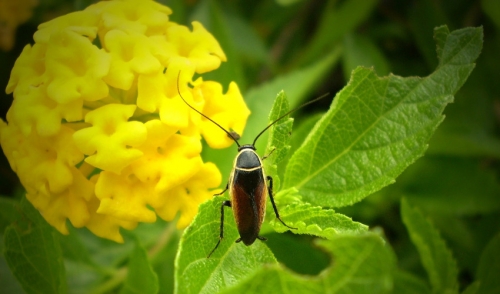{article.name}
What Is Bugging Your Garden?

- Share this:
- Share on Facebook
- Pin on Pinterest
- Tweet on Twitter
Many gardeners have a love-hate relationship with the bugs in their garden. There are insects that are undeniably beneficial and great residents, as they enhance pollination, improve soil quality and defend plants against more aggressive, harmful bugs and other wildlife. Other insects, however, can damage foliage, stunt growth and taint produce. But which bugs are in your garden and when do they become a problem you will need to contend with?
How Bad Is Bad?
It is impossible to completely eliminate every harmful insect from the garden, but you can mitigate their intrusions and minimize the damage they cause. What each gardener must decide, however, is how much damage is just too much for their individual preference. For some gardeners, a small amount of loss is acceptable if it means they don't need to use harsh pesticides, while others may prefer to remove as many harmful insects as possible. The choice is always a personal one, and you will need to decide just how closely you want to coexist with all the insects in your garden.
Top 8 Garden Bugs to Be on Guard For
While the exact bugs that invade any garden will vary depending on the region, climate, plants, weather patterns, season and other factors, there are some bugs that are widespread and troublesome to gardeners in many different areas. The top bugs to watch out for that are most harmful to your garden are…
- Aphids
These tiny, pale green, pear-shaped bugs appear in large groups. They suck sap from plants, causing wilting and slow growth, and they exude a sweet honeydew that contributes to sooty mold growth. To control aphids, encourage ladybugs and praying mantises in your garden, spray the pests with hot pepper sprays or use neem oil or other horticultural insecticides for severe infestations.
- Colorado Potato Beetles
These round beetles have an orange head and bold black and white or orange stripes on their wing covers. They quickly defoliate not only potatoes, but also tomatoes, eggplants, peppers and other plants. To control these aggressive pests, use deep straw mulch around plants, encourage ladybugs and hand pick them whenever possible to reduce their population.
- Japanese Beetles
These insects may be attractive with their metallic blue-green bodies and bronze wing covers, but they can do serious damage when they skeletonize plants. The fat white grubs with their brown heads feed on the roots of turf grass, causing bare brown patches. Beneficial nematodes can help control these beetles, and insecticide traps are also effective. Because these bugs are a serious pest in many areas, report infestations to your local agricultural office in case more drastic measures may be necessary.
- Scales
These insects appear as white pale lumps on both indoor and outdoor plants, and they suck the sap of the plants where they are feeding. This causes wilting and stunts growth, and can kill the plants in severe infestations. They also exude honeydew which can foster sooty mold growth. To control scales, protect ladybugs and praying mantises in your garden, prune away infested plants and use neem oil sprays.
- Snails
These slow-moving, shelled mollusks can do severe damage as they chew on foliage of both garden and landscaping plants alike, leaving their slimy mucous trails behind. Because they're slow, however, hand-picking is an effective method of control, and you can also encourage birds such as jays that will happily eat snails. Minimizing watering after dark will make your garden less snail-friendly, and so will applications of diatomaceous earth around delicate plants.
- Tomato Hornworms
These huge caterpillars are often missed because of their excellent green camouflage and diagonal stripes that break up their outline. You can't miss their damage, however, as they chew through leaves, stems and even fruit. Hand-picking is an easy way to eliminate them, and tilling the soil in late fall and early spring will kill many overwintering larvae. Ladybugs can also help keep tomato hornworms in check.
- Grasshoppers
These leaping insects are instantly recognizable with their long, jointed legs, large heads and strong jaws. Those jaws will defoliate leaves and stems of a wide variety of crops and landscaping plants, but grasshoppers can be discouraged by using row covers on young garden plants. Other effective control techniques include encouraging birds in the yard to eat the grasshoppers, as well as rototilling in the fall or spring to destroy overwintering grasshopper eggs.
- Armyworms
These brown or greenish larvae march across crops like an army, chewing through leaves and skeletonizing plants as well as gouging into fruits. They are most active at night, but hand-picking can be effective to help control small infestations. When more armyworms are present, neem oil applications or other insecticides may be necessary. Other control options include ladybugs, beneficial nematodes and encouraging birds that will eat the worms.
Recognizing these most common and troublesome insects is the first step toward protecting your garden and ensuring healthy, productive crops without being overrun by bugs.



Comments